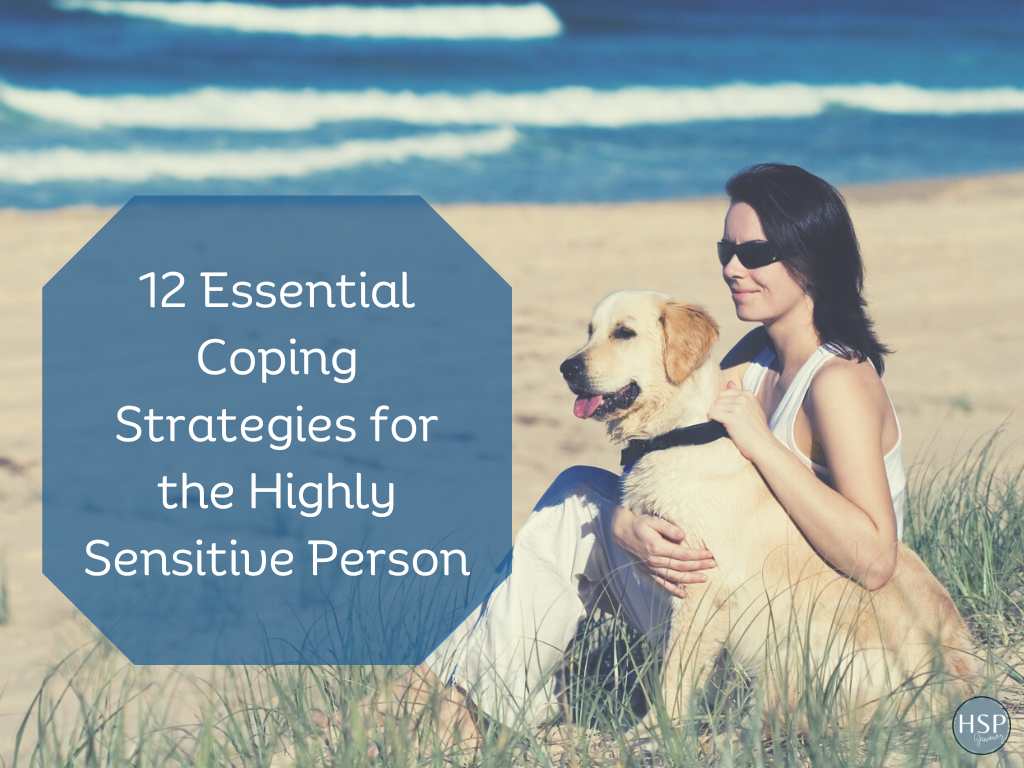In talking with highly sensitive people on a regular basis, I have noticed that most of us require a solid roster of coping strategies for the Highly Sensitive Person (HSP) to effectively manage our nervous systems. Because HSPs have more mirror neurons and therefore take in more stimuli through all of our five senses, it’s fairly normal to need more downtime and coping strategies than other non-sensitive people.
Often, HSPs get flummoxed, rattled, or offended more easily by what other people say or do. We also generally dislike loud noise, stressful situations, yelling, violence, and gore. I’m willing to be not a day (or maybe even an hour) goes by that you don’t need one or more of these coping strategies. I use all of these in my own life nearly every week and hope that you find my recommendations useful.

Table of Contents
What is a coping strategy?
You might be wondering, what exactly is a coping strategy? Well, it’s a fancy term that really just means responding to your needs in a way that is calming. Because HSP brains respond in greater measure to environmental stimuli, we need to pay attention and calm our nervous systems down to be in a relaxed and peaceful state. For some HSPs, they have lived practically their whole lives in an elevated state, as though they were in fight/flight/freeze all the time. Once you begin to understand how your nervous system works, it will make more sense as to why you need more coping strategies for the Highly Sensitive Peron.
A coping strategy is a way of dealing with or managing a difficult or stressful situation. It can be a technique, behavior, or thought process that helps individuals to reduce stress, anxiety, and negative emotions. Coping strategies can be healthy or unhealthy, and they can be learned and developed over time.
#1 -Tidy Up Your Physical and Mental Space
I have noticed that I’m rarely clear-headed to be productive when my physical space is cluttered. I’m by nature a bit of a neat freak, so before I can get on with my day of work from home, I like to tidy my kitchen, put away the shoes that were left out by my kids, and put away papers or other items left out. I’ve also noticed that if I’m preoccupied with lots of things rattling around in my mind, I’m also not as focused when I sit down to work.
One helpful technique for doing a physical clean-up is to set a timer and use a basket to collect all things that need to get put away. Race the timer to see how quickly you can tidy your space up so that you can move on to other things.
For clutter of the mind, I find that mental offloading is a great technique to use. If you have lots of things on your mind, pull out your journal, a piece of paper, or a notecard, and make a short list (or maybe your list is long) of all the things on your mind. The list is for you, and you don’t necessarily need to come back to it, so list anything and everything (which for us HSPs, could be a long list!)
Are you worried about your kids at school? Did you get into an argument with your mom that is unsettled? Are you concerned about a friend? You get the idea. If you want to, you can set a timer for this exercise as well to challenge yourself to throw up as many things on your mind as you can. Trust me, you’ll feel like a million bucks when you’re done.
#2 – Take a Walk
Walking is perhaps the easiest, most satisfying way to both get exercise and rejuvenate your physical location. If you live in the city, aim to take a short walk to your nearest park or grove of trees. If you live in the suburbs or countryside, enjoy the abundance of nature around you as you walk. For a short walk to be an effective coping strategy for the Highly Sensitive Person, aim to leave your phone at home (gasp!) and try to listen to the birds, notice your surroundings, and enjoy the sun on your face.
#3 – Change Your Physical Location
Sometimes we get stuck in a rut that is connected to a physical location. When you’ve been working all day at your desk but still have more to accomplish, consider changing your physical location to change your energy and quiet your nervous system. Move to another table in your house, move outside to the back patio, head to the library, or go to your nearest (and quietest) coffee shop to boost your energy and change your pace.
#4 – Do Something Creative
I’ve written about how to leverage your creativity to avoid overwhelm, and the same principles can be applied here. When you feel triggered by something someone says that impacts you negatively, try pausing and channeling your feelings into a poem. Or, perhaps you’re musical and you can pick up or sit down at your instrument for five or ten minutes and play something that expresses your anger. Whether you knit, paint, draw stick figures, or sing, doing something creative is a great way to calm your nervous system and get back to a regulated state.
#5 – Try Deep Breathing
One of the easiest breathing exercises is box breathing. Box breathing is a simple breathing technique that can help to reduce stress and anxiety. Here are the steps to do box breathing:
- Find a quiet and comfortable place to sit or lie down.
- Close your eyes and take a deep breath in through your nose, filling your lungs with air.
- Hold your breath for a count of four.
- Slowly exhale through your mouth for a count of four.
- Hold your breath for a count of four.
- Repeat the cycle of inhaling, holding, exhaling, and holding for several minutes, or until you feel calm and relaxed.
The key to box breathing is to focus on your breath and counting, which helps to calm the mind and reduce stress. You can practice box breathing anytime, anywhere, whenever you feel stressed or overwhelmed. I will even do this while waiting at a red light, when talking to that friend who never asks about me, and while waiting in line. Basically, anytime I notice I start holding my breath or breathing heavily because I’m starting to get annoyed.
#6 – Take a Power Nap
Early in my career, I worked for a public relations agency and had anywhere from four to six client projects at a time. It was stressful and took a lot out of me. My office was very close to my house, so during lunch, I’d head home, microwave my leftovers, eat, then take a power nap. Many people decry naps saying that they can’t take naps. Truth is, they haven’t studied how to take a power nap, which is a very specific style of napping.
Here are the directions for taking a 20-minute power nap:
- Find a quiet and comfortable place to lie down or sit. If you’re at work, you can use a break room, a quiet corner, or even your car.
- Set an alarm for 20 minutes to ensure that you don’t oversleep.
- Close your eyes and relax your body. You can use a pillow or blanket to make yourself more comfortable. (I like to use ocean sounds on my White Noise Light app as another cue that it’s nap time.)
- Focus on your breath and try to clear your mind of any thoughts.
- If you find it difficult to fall asleep, try using a relaxation technique such as deep breathing or progressive muscle relaxation.
- When your alarm goes off, wake up slowly and take a few deep breaths before getting up.
- Take a few minutes to stretch and move your body to help wake yourself up.
Remember, a power nap is meant to be a short nap that helps to boost your energy and productivity. It’s important not to oversleep, as this can leave you feeling groggy and disoriented. A 20-minute nap is usually the perfect amount of time to feel refreshed and rejuvenated. I’m here to tell you power naps are revolutionary and will change your life. In the beginning, it will take some time to adjust, but after about a week, you’ll find that you may not even need that afternoon cup of coffee!
Looking for HSP Tools to Thrive in a Chaotic World?
The modern world is often overwhelming and stressful for those of us with sensitive nervous systems. Many of us have suffered from the challenges of high stress, anxiety, sensory overload, and mental health and physical health issues. Fortunately, after years of working with and researching Highly Sensitive People (HSPs), Julie Bjelland has developed many tools that have not only helped her but thousands of HSPs all over the world move out of survival mode living and into thriving. In this free webinar, she’ll share the tools that HSPs have found the most life-changing. Her goal is to help you live to your fullest potential because the world needs you.
Join this free webinar and get tools to help you thrive as an HSP!
#7 – Call a Friend
Your co-worker just yelled at you again despite your calm request for them to lower their voice and respectfully request changes to the report in writing. In this situation, you might need to combine some of these coping strategies and take a walk outside your office while calling a friend to unload. Pick a spouse, close friend, or trusted family member and ask if you can just vent for a couple of minutes. Let me know you aren’t seeking advice (unless you are) and that you just need to let off some steam. We’ve all been there–sensitive or not–so close relationships can withstand some occasional venting. At the end of the call, make sure to thank them and ask when you can call them back to hear about what’s going on in their life.
#8 – Pet Your Pet
Studies have shown that interacting with a pet can help to lower stress levels. One study found that petting a dog for just ten minutes can lower cortisol levels, a hormone associated with stress. If you have a dog, cat, bird, or other pet that brings you joy, take a ten-minute break to stroke their fur, play with them, or give them love in some way. It will help you feel better and show them you love them at the same time. This coping strategy can also be combined with taking a walk and getting into nature. Take your dog out for a short walk, then pet them while enjoying the shade of a nearby tree.
#9 – Do Mild Stretching or a Short Yoga Routine
Taking time out to do some light stretching or a short yoga routine can not only calm your nervous system, it can help your body let go of unwanted stress in muscles and facia. Try YouTube for some short ten-minute yoga routines or even a podcast app for a yoga routine. Or, if you know some poses and stretches by memory, try writing a short routine down on a notecard so that you don’t have to think when you decide to stretch. You can just grab your card and get to stretching. This is a great break after putting in work at your computer for hours or dealing with a difficult client. I often find that having a transitional activity between phone calls, meetings, or writing projects helps me maintain my energy and focus.
#10 – Use a Meditation App
There are a number of great meditation apps available that offer short audible meditations for the amount of time you have to spend. If you don’t want to get another app, you can find Calm Meditations on YouTube along with other creators offering valuable ways to calm down. One coach I worked with challenged me to do a ten-minute meditation daily for 30 days. While this was hard, it helped me slow down and notice when I was stressed.
#11 – Journal to Unload Emotions and Stress
Journaling can be combined with mindfulness or a spiritual reflective practice. It’s an essential element of The Artist’s Way by Julia Cameron. This book includes a daily task of writing pages, which helps get the inner creative juices flowing again. For the sake of calming the nervous system, spending just a few moments journaling can be very useful in writing things that you can’t say to anyone or being honest with yourself to bring about peace, healing, and freedom.
#12 – Ground Yourself in Nature
Highly sensitive folks like you and me are deeply connected to nature and find that we crave it like water or air to breathe. If you live in a city or have noise from traffic (or noise from yard blowers in your neighbor’s yard as I do right now) you are not alone. You may need to drive to a state park or walk in a new neighborhood to get the boost you need from nature.
It may give you joy to know that we are both under the same sky right now, moving together speedily through space on the very same planet. Go outside, take your shoes and socks off, and walk in the grass. Put your feet in the pool, Lay down on the driveway, and look at the clouds. Any small thing you can do to recognize that we are all in this journey of life together will help you cope with the intensity of being a Highly Sensitive Person, which is a wonderful and precious gift.
Be sensitive, be free
*This post contains affiliate links and I will be compensated if you make a purchase after clicking on my links*





[…] a Highly Sensitive Person finds that Tai Chi and Yoga are lovely practices to do from the comfort of their own homes or in […]